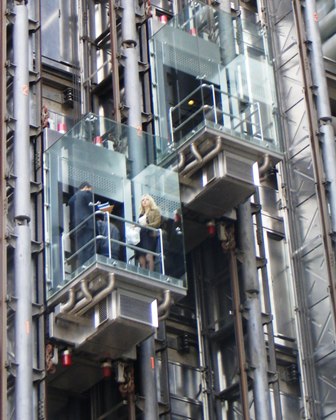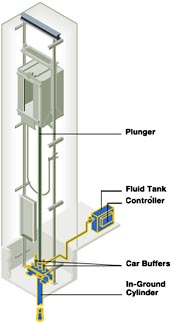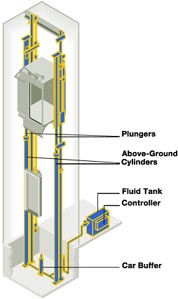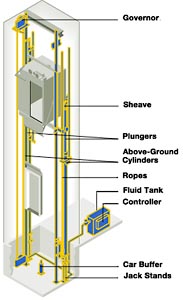Architectural Project 6

SHERIDAN INSTITUTE
ARCH34231
Davis Campus, Brampton
|
Architectural Project 6 |
|
SHERIDAN INSTITUTE |
|
ARCH34231 |
Davis Campus, Brampton |
MODULE #8C - VERTICAL TRANSPORTATION
Learning Outcomes
In Ontario, elevating devices are required for barrier free design as stated in the Accessibility for Ontarians with Disabilities Act. Therefore, during the Design Development Phase of a project, consideration must be given to modes of vertical transportation especially as this affects aesthetics, budget, structure and the circulation of goods and people. The first major decision regarding the choice of an elevating device is aesthetic/budgetary. Will the elevator be a sculptural (read expensive) statement or a minimalist functional concern to be efficient and low impact.(read less expensive)
How much of the project budget that will be allocated for the elevating device will depend partly upon the desired statement. Once the type of elevator is determined, then the design team must consider the implications for implementation of this decision....the research must discover the space, shaft, equipment, pit, over run, and penthouse requirements. In an existing building retrofit or adaptive re-use the electrical and structural implications become especially significant. This module is intended to simulate the decision making and implementation processes of elevating device selection.
Contents
|
|
|
|
 |
| Glass walled shaft at the Cleveland Museum of Modern Art | Glass walled shaft at the Cleveland Museum of Modern Art has a glass roof and proprietary clips to hold it al together | Institut du Monde Arabe, Paris France Interior atrium elevator...shaftless with a metal cab and glass back wall | Lloyds of London exterior shaftless glass elevator |
|
|
|
|
|
| The sculptural lift in the Musee du Louvre, Paris France. goin' down! | |||
| Because of its many complexities, an elevator system is generally designed by an elevator consultant, or the design department of the manufacturer. What is usual is for the designer to lay out the elevator in somewhat general terms, and then the manufacturer prepares a "shop drawing" which guides the actual installation. | ||
| Some basic guidelines have been provided on pages 181 to 182 of TASC (The Architect's Studio Companion). | ||
A minimal requirement for an elevating device to meet the requirements of barrier-free access could be provided by a Handicapped Lift. These lifts are regulated by a portion of the Ontario Elevating Devices Act which refers to elevators with platforms of 25 sq. ft. or less, and with a run of no more than 26 feet. |
||
| The footprint of a Handicapped lift is usually close to square, but you can also get a unit which is 3 feet in width and 7 feet long. Concord Elevator is a prominent manufacturer of such lifts. | ||
| There are a number of different "drives" for passenger elevators: | ||
|
Conventional Hydraulic
|
 |
|
| Holeless Hydraulic |
|
|
| Holeless Dual Cylinder |
 |
|
| Roped hydraulic |
 |
|
Geared traction
|
||
3. OBC Requirements related to Elevator Equipment
| Section 3.5 "Vertical Transportation" of the OBC deals with elevator and elevator shaft requirements. |
| Elevator shafts will extend through floorplates which will generally be required to maintain a fire separation. The requirements of these fire separations are always related to the floor ratings. Specific requirements are laid out in table 3.5.3.1 of the OBC. For example, where floors are required to have a 45 minute FRR, the walls of the elevator shaft must provide a FRR of 45 minutes. |
| The ratings of elevator doors are regulated by section 3.1.8 of the OBC. Table 3.1.8.4 indicates the FRR of a closure relative to the rating of the wall in which it is located. A 45 minute wall, would require a 45 minute closure, for example. |
| The elevator machine room will have to be separated from other parts of the building by the same rating as the elevator shaft, but there is no need to fire separate the shaft from the machine room (luckily...given the equipment which must pass between the two in some elevator designs). |
| It is part 3.8 of the OBC which makes the connection between the presence of elevators and barrier-free access--essentially, if elevator access is provided to a floor level, it must be developed as an accessible floor. The height of elevator controls are regulated by OBC section 3.8.1.5. |
| When a building exceeds three storeys in height, it is required to have an elevator which is adequate in size to accommodate a stretcher, that is at least 6'-7" long and 2'-0 wide, except for in the instance of a hospital or residential care facility (B2 or B3 occupancy) in which case such an elevator is required irregardless of building height. |
| Please refer to the Province of Ontario Elevating Devices Act and Ontario Occupational Health and Safety Act and WHMIS Regulation for further concerns. |
4. Sizing of Elevator Equipment
| There are a number of building types where the sizing and speed of the selected elevators is critical to the functioning of the building: apartment towers, office towers, hotels, hospitals, etc. In the case of a church, a school or a recreational centre, an elevator or two is generally included only to facilitate the movement of goods from floor to floor, and the occasional infirm or handicapped person. Sometimes elevators are used as a means of maintaining the security of an area (access to a parking garage, for example). |
| Any of the areas of your complex intended to accommodate large numbers of people will general have level access, or access by way of a grand staircase. An escalator might be a possibility. |
| In the case of most of your designs, the elevator (or elevators) is a supplementary form of access from floor to floor, and likely one elevator, of small dimension will be adequate. |
| Page 207 of TASC (4th edition) provides some criteria for determining the number of elevators, as well as the usual sizes of elevator cars/shafts of various capacities. |
5. Detailing Concerns related to Elevators
| As we move toward the technical drawing phase of our project, you should be developing the detail of the following issues. | |
| Elevators |
|
|
TASC Reference: Pages 181-182 |
|
| Codes and Regulations: | |
| Ontario Building Code 2006 | |
| Ontario Elevating Devices Act (http://www.e-laws.gov.on.ca/DBLaws/RepealedStatutes/English/90e08_e.htm) | |
| Occupational Health and Safety Act and WHMIS Regulation | |
| Ontario Technical Standards and Safety Act (as it relates to Elevators) (http://www.canlii.org/on/laws/regu/2001r.209/20050511/whole.html) | |
| Elevator Selection and Design | |
| http://en.wikipedia.org/wiki/Elevator#Types_of_elevator_hoist_mechanisms | |
| http://www.otisworldwide.com/k2-elevators.html | |
| Canadian Building Digest No. 190 (http://irc.nrc-cnrc.gc.ca/cbd/cbd190e.html) | |
| Choosing an elevator (DELTA): http://www.delta-elevator.com/elevatorproducts/index.html | |